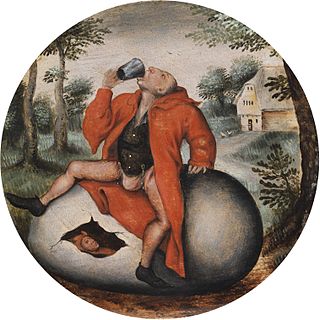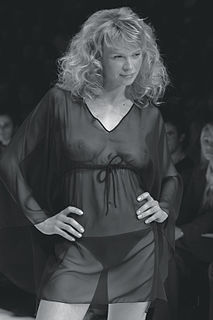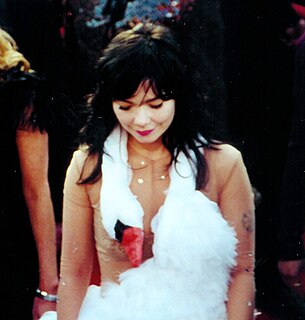Medieval fashion may refer to:

Fashion is an aesthetic expression, at a particular period and place and in a specific context, of clothing, footwear, lifestyle, accessories, makeup, hairstyle, and body proportions. Whereas a trend often connotes a peculiar aesthetic expression and often lasting shorter than a season, fashion is a distinctive and industry-supported expression traditionally tied to the fashion season and collections. Style is an expression that lasts over many seasons and is often connected to cultural movements and social markers, symbols, class, and culture. According to sociologist Pierre Bourdieu, fashion connotes "the latest difference."

A jumper or jumper dress, pinafore dress or informally pinafore or pinny is a sleeveless, collarless dress intended to be worn over a blouse, shirt, T-shirt or sweater. Hemlines can be of different lengths and the type of collar and whether or not there is pleating are also variables in the design.

A codpiece is a covering flap or pouch that attaches to the front of the crotch of men's trousers, enclosing the genital area. It may be held closed by string ties, buttons, folds, or other methods. It was an important fashion item of European clothing during the fifteenth and sixteenth centuries. In the modern era, clothing devices with similar functions as codpieces are worn in some styles of underwear, in the leather subculture, and in performance costumes, such as for rock music and metal musicians. A similar device with rigid construction, an athletic cup, is used as protective underwear for male athletes.
International style may refer to:
Gangsta may refer to:

Draper was originally a term for a retailer or wholesaler of cloth that was mainly for clothing. A draper may additionally operate as a cloth merchant or a haberdasher.
Bases may refer to:

Diane von Fürstenberg is a Belgian fashion designer best known for her wrap dress. She initially rose to prominence when she married into the German princely House of Fürstenberg, as the wife of Prince Egon von Fürstenberg. Following their separation in 1972 and divorce in 1983, she has continued to use his family name.
Clothing terminology comprises the names of individual garments and classes of garments, as well as the specialized vocabularies of the trades that have designed, manufactured, marketed and sold clothing over hundreds of years.

Bloomers, also called the bloomer, the Turkish dress, the American dress, or simply reform dress, are divided women's garments for the lower body. They were developed in the 19th century as a healthful and comfortable alternative to the heavy, constricting dresses worn by American women. They take their name from their best-known advocate, the women's rights activist Amelia Bloomer.

A mantua is an article of women's clothing worn in the late 17th century and 18th century. Originally a loose gown, the later mantua was an overgown or robe typically worn over stays, stomacher and a co-ordinating petticoat.
Medieval Greece refers to geographic components of the area historically and modernly known as Greece, during the Middle Ages.

The following is a chronological list of articles covering the history of Western fashion — the story of the changing fashions in clothing in countries under influence of the Western world — from the 5th century to the present.

A gown, from the Saxon word, gunna, is a usually loose outer garment from knee- to full-length worn by men and women in Europe from the Early Middle Ages to the 17th century, and continuing today in certain professions; later, gown was applied to any full-length woman's garment consisting of a bodice and attached skirt. A long, loosely fitted gown called a Banyan was worn by men in the 18th century as an informal coat.
Old-fashioned may refer to:

Julien Fournié is a French fashion designer and CEO of his own eponymous haute couture company founded in the summer of 2009. Previously, he was the last Creative Director of the Paris-based haute couture fashion house Torrente. In 2008, he was named Creative Director for womenswear, menswear and accessories at Ramosport.

See-through clothing is any garment of clothing made with lace, mesh or sheer fabric that allows the wearer's body or undergarments to be seen through its fabric. See-through fabrics were fashionable in Europe in the eighteenth century. There was a "sheer fashion trend" starting with designer clothing from 2008. See-through or sheer fabric, particularly in skintone colours, is sometimes called illusion, as in 'illusion bodice' due to giving the impression of exposed flesh.

A Madiba shirt is a loose-fitting silk shirt, usually adorned in a bright and colourful print. It became known in the 1990s, when Nelson Mandela—then elected President of South Africa—added the item to his regular attire. Mandela popularised this type of shirt, elevating the seemingly casual garment to formal situations.

Fashion design is the art of applying design, aesthetics, clothing construction and natural beauty to clothing and its accessories. It is influenced by cultural and social attitudes, and has varied over time and place.

The swan dress is an iconic dress resembling a white swan worn by the Icelandic artist Björk at the 73rd Academy Awards on 25 March 2001. A Debenhams poll published in The Daily Telegraph in 2008 voted it the ninth-most iconic red-carpet dress of all time. Björk's swan dress was reimagined by Valentino at its Spring 2014 Couture fashion show at Paris Fashion Week, which received praise from fashion blogs and social media.